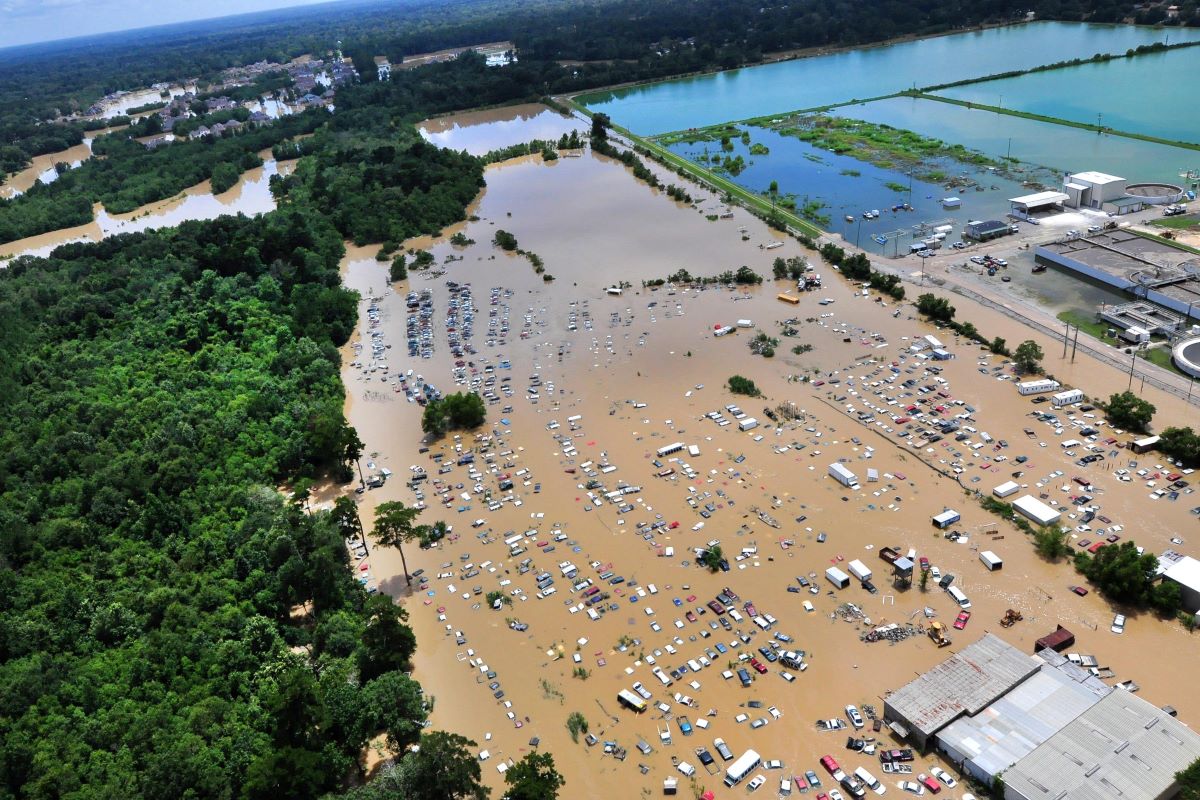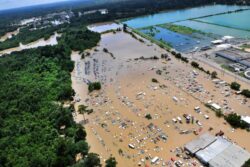2016 Floods
A rainy weekend in August 2016 unexpectedly left behind more than three times the amount of rain dropped by Hurricane Katrina, damaging 146,000 homes in fifty-six of Louisiana’s sixty-four parishes.

United States Department of Agriculture
Flooding in Baton Rouge.
It was supposed to be a rainy August weekend in Louisiana, like countless others. Instead, by Friday, August 12, the rainy weekend had grown into a flooding threat as a low-pressure system pushed torrential downpours between state lines east of Baton Rouge and west of Lafayette. The rain, coined the “no-name storm,” mimicked a hurricane in its rain production and slow movement, wreaking havoc as it crossed the state at a snail’s pace over four days. Befuddling meteorologists and the public alike, the storm quickly turned into a disaster as rainfall accumulated two to three inches per hour in many areas, equaling 7.1 trillion gallons, roughly three times the amount of water left behind by Hurricane Katrina.
For four days, Louisianans suffered as the waters rose. Northeast of Baton Rouge in Watson, water accumulation reached a whopping 31.39 inches. Nearby Livingston Parish, including Denham Springs, suffered extensively, with roughly seventy-five percent of the homes left in “total loss” by the end of the floods. In the Lafayette area, the Vermilion River changed direction, running upstream and causing extensive flooding within the city and parish. Meanwhile, the newly constructed suburb of Youngsville drowned in water. For the first time in Louisiana history, Baton Rouge flooding forced the governor and his family out of the Governor’s Mansion when chest-high water filled the basement.
Within a day, rescue operations were necessary for a wide swath of Louisiana’s affected parishes. Louisiana Governor John Bel Edwards mobilized the National Guard, Coast Guard, State Police, and emergency management affiliates to assist in the rescues, and demands for aid increased as parish agencies received over eleven thousand requests for rescue or assistance. Many roadways also lay impassable, like the flooded sixty-two-mile stretch of Interstate 12 between Tangipahoa Parish and Baton Rouge that trapped 1,500 motorists for over twenty-four hours.
Social media such as Facebook and Twitter played a distinct role in flood response. On social media, calls for assistance rose as pleas for help escalated throughout the multi-day period. Volunteer rescuers quickly took to the flooded roadways to assist, similar to what some had done after Hurricane Katrina, but they used social media such as the Acadiana Flooding Message Board, a public Facebook group, among others, to connect more effectively with those in need. These volunteers performed rescues and delivered supplies in boats, high water capable vehicles, and even canoes. Some volunteer rescuers set up informal groups colloquially known as the “Cajun Navy,” later formalizing into several volunteer rescue organizations by similar names after the flood. Meanwhile, local businesses helped coordinate supplies and provided food and water to those in need. For example, Waitr, a mobile food delivery service, used its app and drivers to locate individuals willing to donate supplies or food to larger distribution centers run by the United Way of Acadiana. Reports of flood experiences on social media also drew support from donors outside the region. Donated funds poured in from singers like Lady Gaga and Taylor Swift, and comedian Ellen DeGeneres. Beyoncé with her sister Solange, Kelly Rowland, Harry Connick Jr., and Randy Jackson held benefits.
By August 15, more than ten of Louisiana’s rivers had reached flood stage, but the rains had fortunately stopped. Unfortunately, sixty individuals had lost their lives due to the flooding and its aftermath, and an estimated 146,000 homes in fifty-six of Louisiana’s sixty-four parishes lay damaged by floodwaters, bringing the damages to roughly $15 billion. The floods also significantly impacted crop production, devastating sugar cane, corn, rice, and late-season soybean crops.
The 2016 Floods brought flooding to areas that had never flooded during past hurricanes, historic floods, or other rains. In Lafayette, the rainfall totals indicated the event was between a one-hundred- and two-hundred-year flood event; in other areas of the state, the totals equated to more of a five-hundred-year flood event. While the rare low-pressure system that created the rain was unique, the flooding experienced was largely attributed to increased climatic change and rapid development within the last decades in the regions affected.
Unfortunately, the rarity of the event made it hard to prepare for and recover from. Unlike with a hurricane or riverine flood events, very little preparatory work had been done beforehand in setting up shelters, preparing sandbag distribution facilities, and readying properties. This lack of preparation, along with the flooding’s sudden onset, slowed response times to calls for assistance. In its aftermath, the “no-named storm” became a disaster relief conundrum as it did not fit the guidelines for regular flooding events or hurricanes. In many parishes hit hardest by the floods, homeowners did not carry flood insurance because they did not know they lived in a flood zone or did not expect to flood based on their knowledge of previous historical flooding events. This complicated recovery as these homeowners were left without flood recovery assistance and relied solely on federal aid.
Overall, the 2016 Floods served as a formative event for Louisiana, on par with significant past hurricanes (including Hurricanes Katrina and Rita) and floods that had shaped its history prior (like the Great Flood of 1927). However, it also served as a distinctive catalyst for change. It spurred new research on flooding in Louisiana, education on flood maps, zones, mitigation efforts, and disaster response. It also encouraged the continued growth of social media disaster volunteer efforts, such as the multiple groups of “Cajun Navy” that have mobilized for recent hurricane and flooding disasters.
